
Morehead City is a port city in Carteret County, North Carolina, United States. The population was 8,661 at the 2010 census. Morehead City celebrated the 150th anniversary of its founding on May 5, 2007. It forms part of the Crystal Coast.
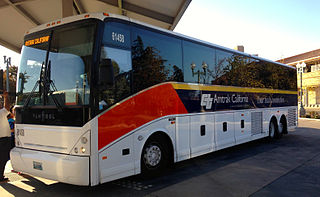
Amtrak Thruway is a system of through-ticketed transportation services to connect passengers with areas not served by Amtrak trains. In most cases these are dedicated motorcoach routes, but can also be non-dedicated intercity bus services, transit buses, vans, taxis, ferry boats and commuter rail trains.

The Silver Star is a temporarily discontinued long-distance passenger train operated by Amtrak on a 1,522-mile (2,449 km) route between New York City and Miami via Washington, D.C.; Richmond, Virginia; Raleigh, North Carolina; Columbia, South Carolina; Savannah, Georgia; Jacksonville, Florida; and Tampa, Florida.

The Palmetto is a passenger train operated by Amtrak on a 829-mile (1,334 km) route between New York City and Savannah, Georgia, via the Northeast Corridor, Washington, D.C., Richmond, Virginia, Fayetteville, North Carolina, and Charleston, South Carolina. The Palmetto is a shorter version of the Silver Meteor, which continues south to Miami, Florida. From 1996 to 2002 this service was called the Silver Palm. Although currently a day train, the Palmetto is considered a long-distance train by Amtrak and previously provided overnight sleeper service to Florida.
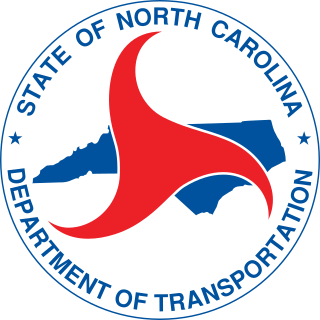
The North Carolina Department of Transportation (NCDOT) is responsible for building, repairing, and operating highways, bridges, and other modes of transportation, including ferries in the U.S. state of North Carolina.

The Joseph Scelsi Intermodal Transportation Center is a transit facility located in downtown Pittsfield, Massachusetts, United States. The $11 million facility is named after Joseph Scelsi, a longtime State Representative who represented Pittsfield. Owned by the Berkshire Regional Transit Authority (BRTA), it is serviced by local BRTA bus services, Amtrak intercity rail service, and Peter Pan intercity bus service. The second floor of the building houses two classrooms used by Berkshire Community College and Massachusetts College of Liberal Arts.

Charlotte station is an Amtrak station located at 1914 North Tryon Street, about 1.5 miles (2.4 km) to the northeast of Uptown Charlotte. Owned by Norfolk Southern, it is located near that railroad's yard outside Uptown.

J. Douglas Galyon Depot, also known as Greensboro station, is an intermodal transit facility in Greensboro, North Carolina. Located at 236 East Washington Street in downtown Greensboro, it serves Amtrak passenger rail and is the city's main hub for local and intercity buses.

Cary station is an Amtrak train station located in Cary, North Carolina. It is served by the Floridian, Carolinian, and Piedmont services. The station is the hub for the town's GoCary bus network.

G.K. Butterfield Train Station, also known as Wilson station, is an Amtrak train station in Wilson, North Carolina, United States. It is located in downtown Wilson and is part of the Wilson Central Business–Tobacco Warehouse Historic District.
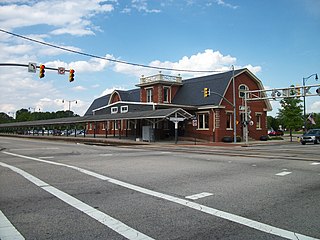
Fayetteville station is an Amtrak train station in Fayetteville, North Carolina, United States. It is located in the Fayetteville Downtown Historic District, next to the Airborne & Special Operations Museum.
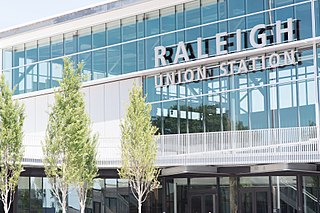
Raleigh Union Station is an intermodal transit station in Raleigh, North Carolina, United States. Train service began the morning of July 10, 2018. Its main building serves as an Amtrak train station, while a future adjacent building will serve as the bus terminus for GoTriangle. The station is located at the Boylan Wye, a railroad junction used by CSX and Norfolk Southern, and adjacent to the Depot Historic District in downtown Raleigh.

Robert J. Cabral Station, is a railway station in Stockton, California. In 2003, the station building was named in honor of the late Robert J. Cabral, a San Joaquin County supervisor instrumental in the creation of the Altamont Corridor Express (ACE), originally Altamont Commuter Express.

Redding station is an intercity train station served by Amtrak's Coast Starlight, located in Redding, California, United States. The depot was built by the Southern Pacific Railroad in 1923 and opened on February 5, 1924. The train station has sheltered waiting areas on both platforms and a parking lot near the southbound platform.

The Carolinian is a daily Amtrak passenger train that runs between New York City and Charlotte, North Carolina, with major stops in Philadelphia, Baltimore, Washington, Richmond, Raleigh, Cary, Durham, and Greensboro. The 704-mile (1,133 km) service is the longest state-supported route in the Amtrak system. Northbound trains leave Charlotte at breakfast time and arrive in New York in the early evening, while southbound trains leave New York during the morning rush and arrive in Charlotte in the evening.

The Piedmont is a regional passenger train operated by Amtrak and the North Carolina Department of Transportation (NCDOT), running four round trips daily between Raleigh and Charlotte, North Carolina. It is a sister train to the Carolinian, which runs from Charlotte to New York City. The Piedmont route is coextensive with the southern end of the Carolinian, largely paralleling Interstate 85. It operates along the western portion of the state-owned North Carolina Railroad, which runs from Charlotte to Morehead City. Operations began in May 1995.
There are many different types of transportation in North Carolina, including air, rail, mass transit, and major highways. North Carolina is a rapidly growing state with over 10.4 million people and requires multiple types of transportation. Currently, NC has 10 commercial and many municipal airports, a passenger rail called NC By Train operated by North Carolina in partnership with Amtrak with many different routes, public bus transportation in cities like Raleigh and Charlotte, and highways that span the State.
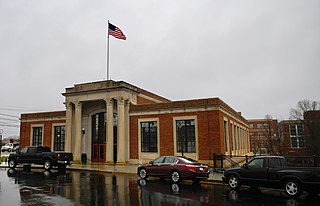
Union Station is a historic train station, currently serving as a bus station, located in Winston-Salem, Forsyth County, North Carolina.

NC By Train is a brand name used by the Rail Division of the North Carolina Department of Transportation (NCDOT) for two state-supported Amtrak routes operating in the U.S. state of North Carolina–the Carolinian and the Piedmont.

Wilmington Union Station was a union station in Wilmington, North Carolina. Opened in 1913, it was designed by architect Joseph F. Leitner. Construction by Boyle-Robertson contractors began in 1912. It was located at Front Street and Red Cross Street in downtown Wilmington.
























